How to turn your project to a Git repo and share it
Objectives
Turn our own coding project (small or large, finished or unfinished) into a Git repository.
Be able to share a repository on the web to have a backup or so that others can reuse and collaborate or even just find it.
Instructor note
10 min introduction and setup
25 min exercise
15 min discussion
Exercise

From a bunch of files to a local repository which we then share on GitHub.
Exercise: Turn your project to a Git repo and share it (25 min)
Create a new directory called myproject with one or few files in it. This represents our own project. It is not yet a Git repository. You can try that with your own project or use a simple placeholder example.
Turn this new directory into a Git repository.
Share this repository on GitHub (or GitLab, since it really works the same).
We offer three different paths of how to do this exercise.
Via GitHub web interface: easy and can be a good starting point if you are completely new to Git.
VS Code is quite easy, since VS Code can offer to create the GitHub repositories for you.
Command line: you need to create the repository on GitHub and link it yourself.
Create an repository on GitHub
First log into GitHub, then follow the screenshots and descriptions below.
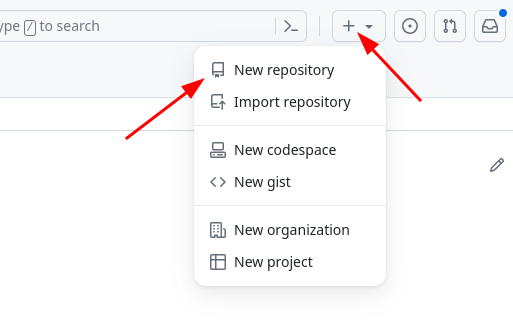
Click on the “plus” symbol on top right, then on “New repository”.
Then:
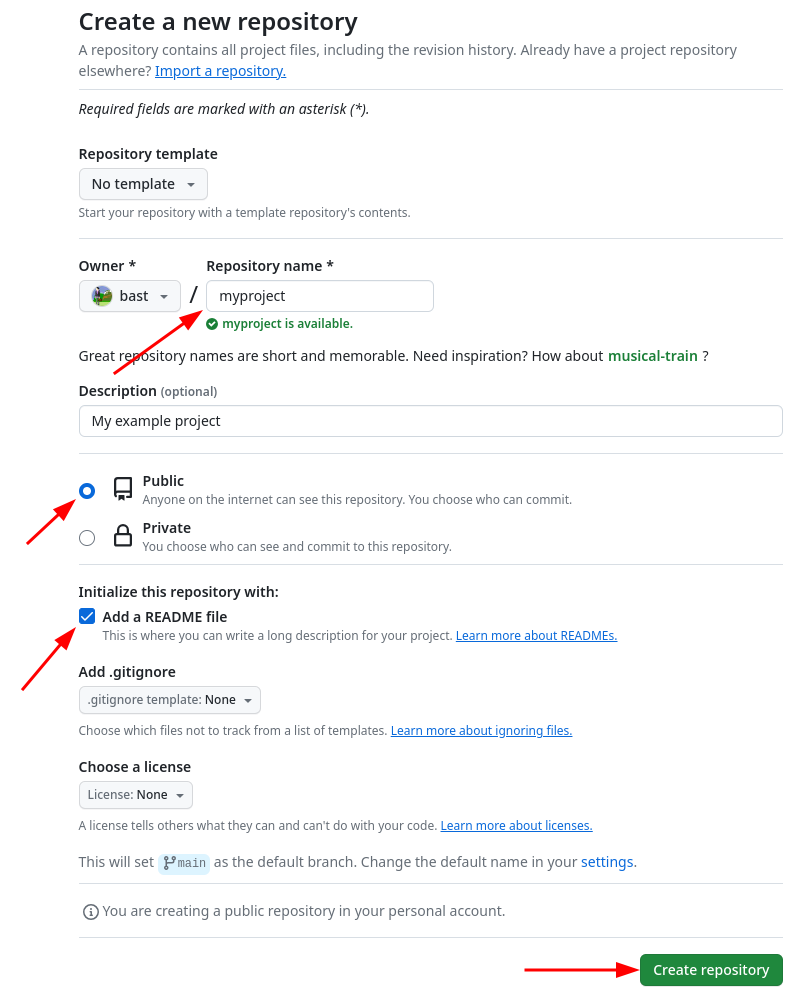
Choose a repository name, add a short description, and in this case make sure to check “Add a README file”. Finally “Create repository”.
Upload your files
Now that the repository is created, you can upload your files:
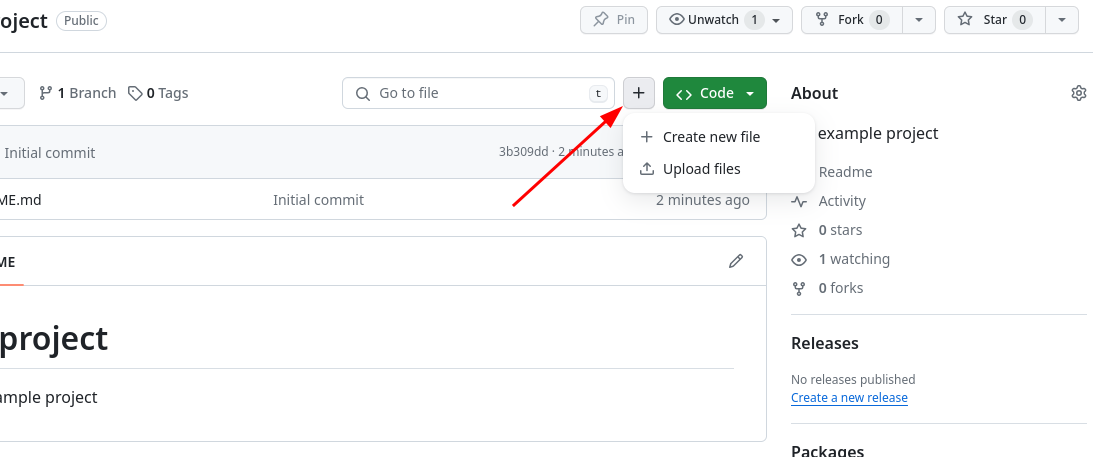
Click on the “+” symbol and then on “Upload files”.
In VS Code it only takes few clicks.
First, open the folder in VS Code. My example project here contains two files. Then click on the source control icon:
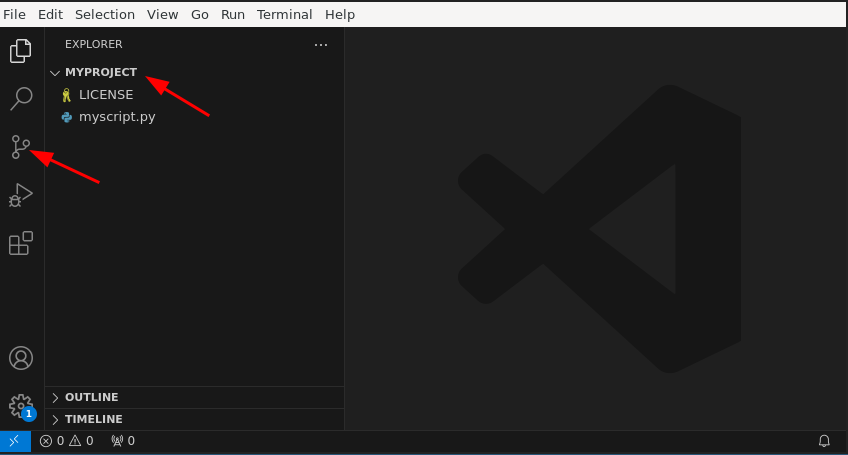
Open the folder in VS Code. Then click on the source control icon.
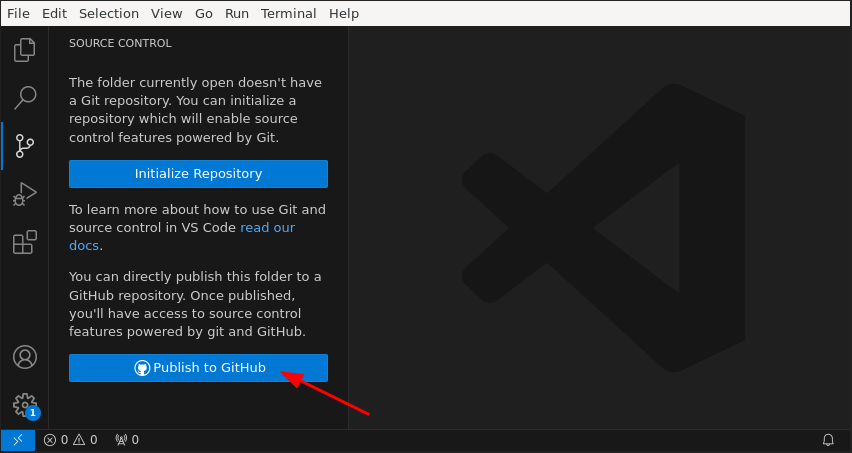
Choose “Publish to GitHub”. In this case I never even clicked on “Initialize Repository”.
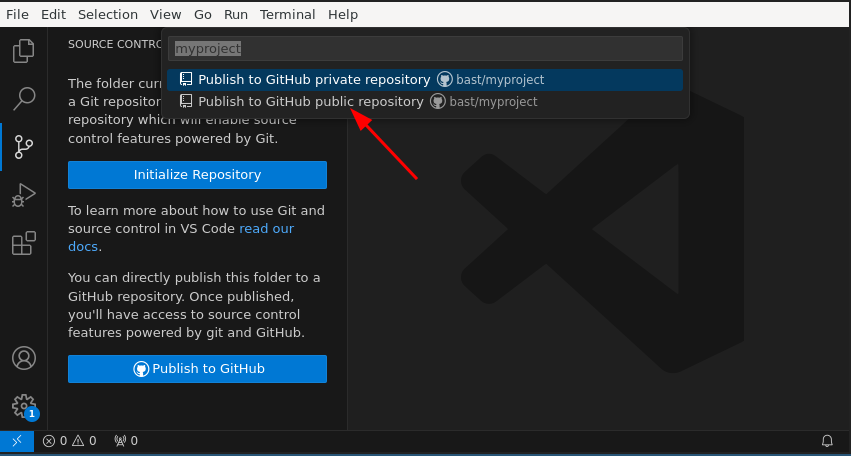
In my case I chose to “Publish to GitHub public repository”. Here you can also rename the repository if needed.
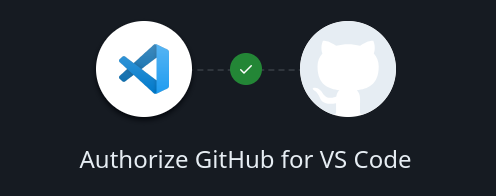
First time you do this you might need to authorize VS Code to access your GitHub account by redirecting you to https://github.com/login/oauth/authorize.
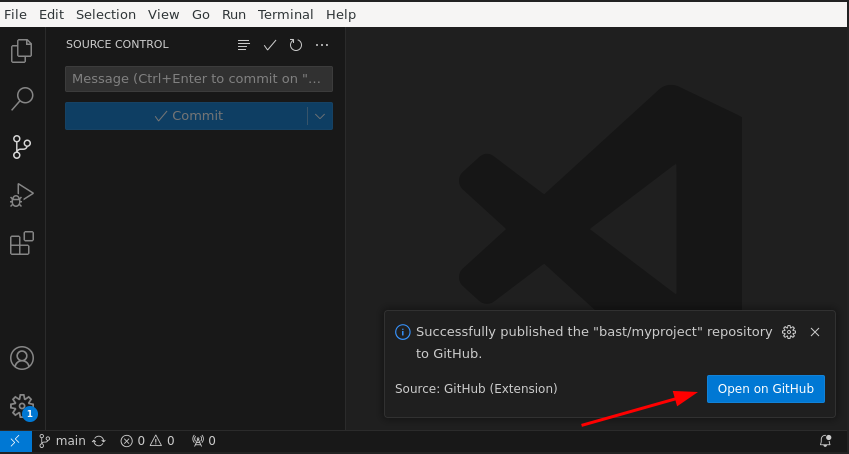
After it is published, click on “Open on GitHub”.
Make sure your Git is configured
We have an own section on this: Configuring Git command line and editor.
Put your project under version control
My example project here consists of two files. Replace this with your own example files:
$ ls -l
.rw------- 19k user 7 Mar 17:36 LICENSE
.rw------- 21 user 7 Mar 17:36 myscript.py
I will first initialize a Git repository in this directory.
If you get an error, try without the -b main (and your default branch will
then be called master, this will happen for Git versions older than
2.28):
$ git init -b main
Now add and commit the two files to the Git repository:
$ git add LICENSE myscript.py
$ git commit -m "putting my project under version control"
If you want to add all files in one go, you can use git add . instead of git add LICENSE myscript.py.
Now you have a Git repository with one commit. Verify this with git log.
But it’s still only on your computer. Let’s put it on GitHub next.
Create an empty repository on GitHub
First log into GitHub, then follow the screenshots and descriptions below.

Click on the “plus” symbol on top right, then on “New repository”.
Then create an empty repository without any files and without any commits:
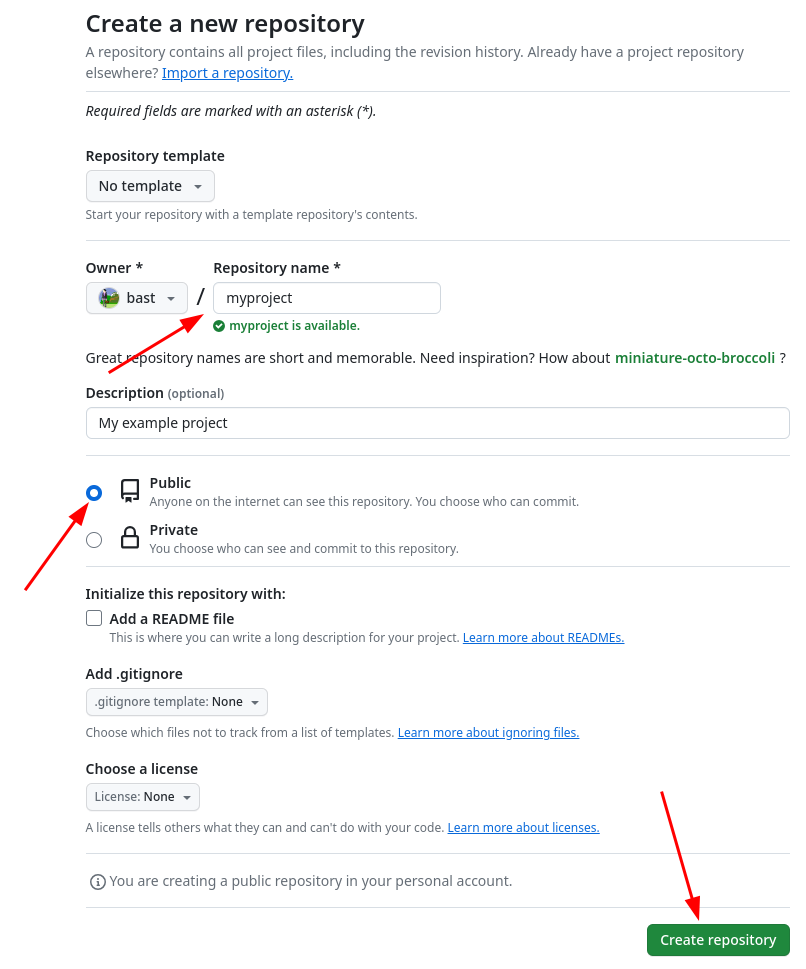
Choose a repository name, add a short description, but please do not check “Add a README file”. For “Add .gitignore” and “Choose a license” also leave as “None”. Finally “Create repository”.
Once you click the green “Create repository”, you will see a page similar to:
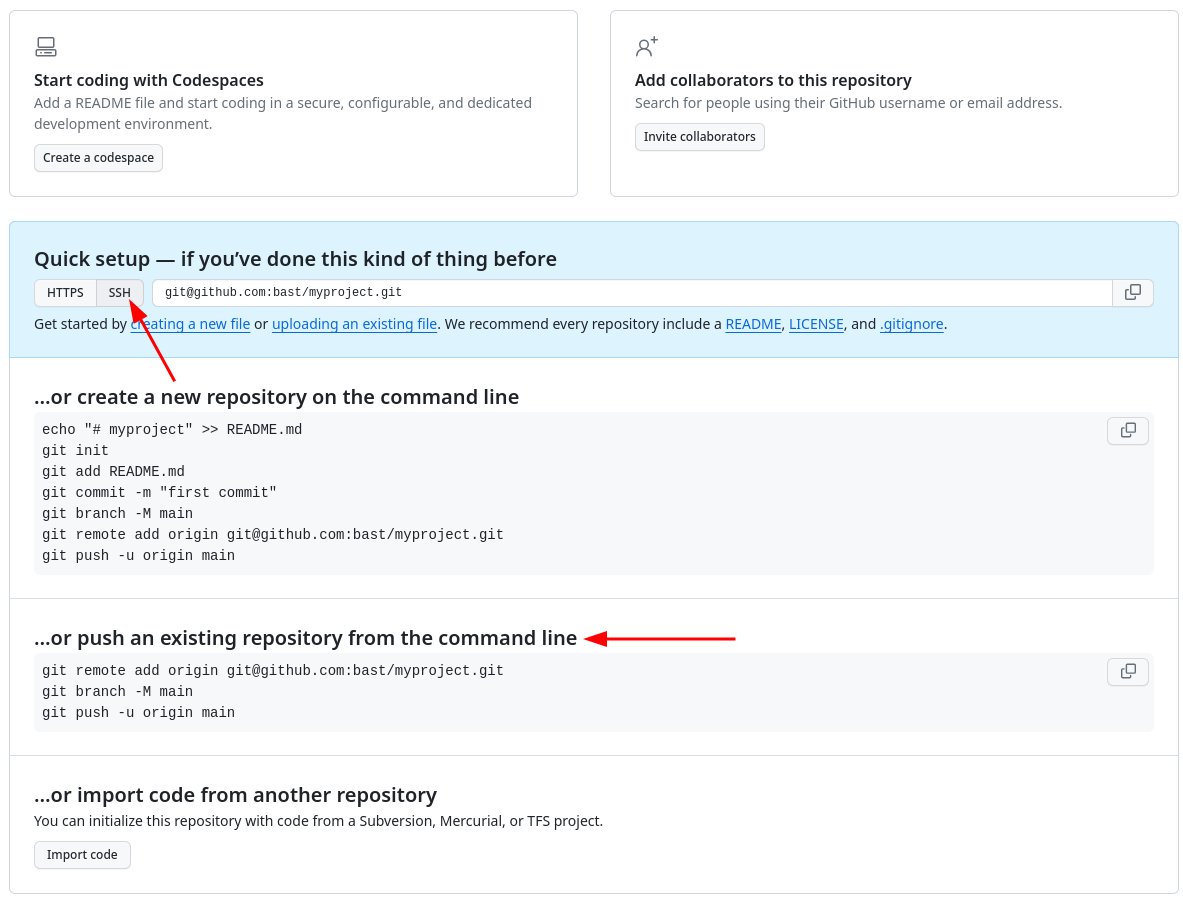
What this means is that we have now an empty project with either an HTTPS or an SSH address: click on the HTTPS and SSH buttons to see what happens.
Push an existing repository from your computer to GitHub
We now want to follow the “… or push an existing repository from the command line”:
In your terminal make sure you are still in your myproject directory.
Copy paste the three lines below the red arrow to the terminal and execute those, in my case (you need to replace the “USER” part and possibly also the repository name):
$ git remote add origin git@github.com:USER/myproject.git
$ git remote add origin https://github.com/USER/myproject.git
Then:
$ git branch -M main
$ git push -u origin main
The meaning of the above lines:
Add a remote reference with the name “origin”
Rename current branch to “main”
Push branch “main” to “origin”
You should now see:
Enumerating objects: 4, done.
Counting objects: 100% (4/4), done.
Delta compression using up to 12 threads
Compressing objects: 100% (3/3), done.
Writing objects: 100% (4/4), 6.08 KiB | 6.08 MiB/s, done.
Total 4 (delta 0), reused 0 (delta 0), pack-reused 0
To github.com:USER/myproject.git
* [new branch] main -> main
branch 'main' set up to track 'origin/main'.
Reload your GitHub project website and your commits should now be online!
Troubleshooting
error: remote origin already exists
Explanation: You probably ran a
git remote add origin ...command, then changed your mind about HTTPS or SSH and then tried to run the othergit remote add origin ...command but “origin” then already exists.Recovery:
First remove “origin” with
git remote remove originThen run the correct
git remote add origin ...command
remote contains work that you do not have
Explanation: You probably clicked on “Add a README file” and now the repository on GitHub is not empty but contains one commit and locally you have a different history. Git now prevents you from accidentally overwriting the history on GitHub.
Recovery:
Use
git push --forceinstead ofgit push, which will force Git to overwrite the history on GitHubNote that this is a powerful but also possibly dangerous option but here it helps us. If it’s a brand new repo, it probably is fine to do this. For real repositories, don’t do this unless you are very sure what is happening.
This is not fully explained, because a lot of it is similar to the “Command line” method (and an RStudio expert could help us some). The main differences are:
Put your project under version control
Tools → Version control → Project setup → Version control system = Git.
Select “Yes” for “do you want to initialize a new git repository for this project.
Select yes to restart the project with RStudio.
Switch to branch
mainto have you branch named that.
Create an empty repository on GitHub
Same as command line
Push an existing repository from your computer to GitHub
Under the “Create new branch” button → “Add Remote”
Remote name:
originRemote URL: as in command line (remember to select SSH or HTTPS as you have configured your RStudio)
The “Push” (up arrow) button will send changes on your current branch to the remote. The “Pull” (down arrow) will get changes from the remote.
Troubleshooting
Same as command line
Remote repositories
In this exercise we have pushed our local repository to a remote repository. You can learn how to work with remote repositories in detail in the collaborative distributed version control lesson.
To store your Git data on another server, you use remotes. A remote is a repository on its own, with its own branches. We can push changes to the remote and pull from the remote.
You might use remotes to:
Back up your own work or make your work findable.
To collaborate with other people.
There are services that can be a remote:
If you have a server you can SSH to, you can use that as a remote.
GitHub is a popular, closed-source commercial site.
GitLab is a popular, open-core commercial site. Many universities have their own private GitLab servers set up.
Bitbucket is yet another popular commercial site.
Another option is NotABug.
There are more …
Is putting software on GitHub/GitLab/… publishing?
It is a good first step but to make your code truly findable and accessible, consider making your code citable and persistent: Get a persistent identifier (PID) such as DOI in addition to sharing the code publicly, by using services like Zenodo or similar services.